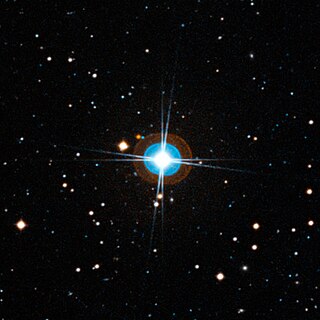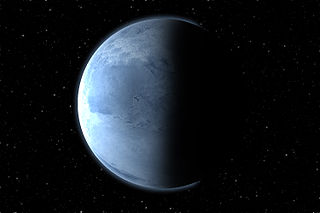Related Research Articles

Pictor is a constellation in the Southern Celestial Hemisphere, located between the star Canopus and the Large Magellanic Cloud. Its name is Latin for painter, and is an abbreviation of the older name Equuleus Pictoris. Normally represented as an easel, Pictor was named by Abbé Nicolas-Louis de Lacaille in the 18th century. The constellation's brightest star is Alpha Pictoris, a white main-sequence star around 97 light-years away from Earth. Pictor also hosts RR Pictoris, a cataclysmic variable star system that flared up as a nova, reaching apparent (visual) magnitude 1.2 in 1925 before fading into obscurity.

82 G. Eridani is a star 19.7 light-years away from Earth in the constellation Eridanus. It is a main-sequence star with a stellar classification of G6 V, and it hosts a system of at least three planets and a dust disk.

Gliese 667 is a triple-star system in the constellation Scorpius lying at a distance of about 7.2 parsecs from Earth. All three of the stars have masses smaller than the Sun. There is a 12th-magnitude star close to the other three, but it is not gravitationally bound to the system. To the naked eye, the system appears to be a single faint star of magnitude 5.89.
HD 85512 is a solitary K-type main-sequence star 36.8 light-years away in the constellation Vela. It is about 1 billion years older than the Sun. It is extremely chromospherically inactive, only slightly more active than Tau Ceti. It exhibits a long-term variability and was thought to host one low-mass planet, although this is now doubtful.

HD 40307 is an orange (K-type) main-sequence star located approximately 42 light-years away in the constellation of Pictor, taking its primary name from its Henry Draper Catalogue designation. It is calculated to be slightly less massive than the Sun. The star has six known planets, three discovered in 2008 and three more in 2012. One of them, HD 40307 g, is a potential super-Earth in the habitable zone, with an orbital period of about 200 days. This object might be capable of supporting liquid water on its surface, although much more information must be acquired before its habitability can be assessed.
HD 40307 b is an extrasolar planet orbiting the star HD 40307, located 42 light-years away in the direction of the southern constellation Pictor. The planet was discovered by the radial velocity method, using the European Southern Observatory's HARPS apparatus, in June 2008. It is the second smallest of the planets orbiting the star, after HD 40307 e. The planet is of interest as this star has relatively low metallicity, supporting a hypothesis that different metallicities in protostars determine what kind of planets they will form.
HD 40307 c is an extrasolar planet orbiting the star HD 40307, located 42 light-years away in the direction of the southern constellation Pictor. The planet was discovered by the radial velocity method, using the HARPS apparatus, in June 2008. Of the six proposed planets in the HD 40307 star system, it is the third-largest, and has the second-closest orbit from the star. The planet is of interest as this star has relatively low metallicity, supporting a hypothesis that different metallicities in protostars determine what kind of planets they will form.
HD 40307 d is an extrasolar planet orbiting the star HD 40307, located 42 light-years from Earth in the direction of the southern constellation Pictor. The planet was discovered by the radial velocity method, using the HARPS apparatus in June 2008. It is the most massive of the six proposed planets in the system. The planet is of interest as this star has relatively low metallicity, supporting a hypothesis that different metallicities in protostars determine what kind of planets they will form.
Gliese 832 b is a gas giant exoplanet about 80% the mass of Jupiter, located 16.2 light-years from the Sun in the constellation of Grus, orbiting the red dwarf star Gliese 832.
Gliese 676 is a 10th-magnitude wide binary system of red dwarfs that has an estimated minimum separation of 800 AU with an orbital period of greater than 20,000 years. It is located approximately 54 light years away in the constellation Ara. In 2009, a gas giant was found in orbit around the primary star, in addition to its confirmation in 2011 there was also a strong indication of a companion; the second gas giant was characterised in 2012, along with two much smaller planets.

HD 10180, also designated 2MASS J01375356-6030414, is a Sun-like star in the southern constellation Hydrus that is notable for its large planetary system. Since its discovery, at least six exoplanets have been observed orbiting it, and some studies have proposed up to nine potential planets, which would make it potentially the largest of all known planetary systems, including the Solar System.
Gliese 163 is a faint red dwarf star with multiple exoplanetary companions in the southern constellation of Dorado. Other stellar catalog names for it include HIP 19394 and LHS 188. It is too faint to be visible to the naked eye, having an apparent visual magnitude of 11.79 and an absolute magnitude of 10.91. This system is located at a distance of 49.4 light-years from the Sun based on parallax measurements. Judging by its space velocity components, it is most likely a thick disk star.

HD 40307 g is an exoplanet candidate suspected to be orbiting in the habitable zone of HD 40307. It is located 42 light-years away in the direction of the southern constellation Pictor. The planet was discovered by the radial velocity method, using the European Southern Observatory's HARPS apparatus by a team of astronomers led by Mikko Tuomi at the University of Hertfordshire and Guillem Anglada-Escude of the University of Göttingen, Germany.
HD 40307 e is an extrasolar planet candidate suspected to be orbiting the star HD 40307. It is located 42 light-years away in the direction of the southern constellation Pictor. The planet was discovered by the radial velocity method, using the European Southern Observatory's HARPS apparatus by a team of astronomers led by Mikko Tuomi at the University of Hertfordshire and Guillem Anglada-Escude of the University of Göttingen, Germany.

Tau Ceti e, also called 52 Ceti e, is an exoplanet orbiting Tau Ceti that was detected by statistical analyses of the data of the star's variations in radial velocity that were obtained using HIRES, AAPS and HARPS. Its possible properties were refined in 2017: it orbits at a distance of 0.552 AU with an orbital period of 168 days and has a minimum mass of 3.93 Earth masses. If Tau Ceti e possesses an Earth-like atmosphere, the surface temperature would be around 68 °C (154 °F). Based upon the incident flux upon the planet, a study by Güdel et al. (2014) speculated that the planet may lie inside the inner-boundary of the habitable zone and closer to a Venus-like world.
Mikko Tuomi is a Finnish astronomer from the University of Hertfordshire, most known for his contributions to the discovery of a number of exoplanets, among them the Proxima Centauri b which orbits the closest star to the Sun. Mikko Tuomi was the first to find indications of the existence of Proxima Centauri b in archival observation data. Other exoplanets to whose discovery or study Tuomi has contributed include HD 40307, HD 154857 c, Kapteyn c, Gliese 682 c, HD 154857, Gliese 221, Gliese 581 g and the planetary system orbiting Tau Ceti. He has led the development of new data analysis techniques for distinguishing observations caused by natural activity of the star and those caused by planets orbiting them.

HD 42936 (DMPP-3) is a star located in the southern circumpolar constellation Mensa. With an apparent magnitude of 9.1, it is too faint to be detected with the naked eye but can be seen with a telescope. The star is relatively close at a distance of about 153 light years but is receding with a heliocentric radial velocity of 34.4 km/s.
References
- 1 2 3 4 5 Tuomi, Mikko; Anglada-Escudé, Guillem; Gerlach, Enrico; Jones, Hugh R. A.; Reiners, Ansgar; Rivera, Eugenio J.; Vogt, Steven S.; Butler, R. Paul (17 December 2012). "Habitable-zone super-Earth candidate in a six-planet system around the K2.5V star HD 40307". Astronomy & Astrophysics. 549: A48. arXiv: 1211.1617 . Bibcode:2013A&A...549A..48T. doi:10.1051/0004-6361/201220268. S2CID 7424216.
- ↑ Wall, Mike (November 7, 2012). "'Super-Earth' Alien Planet May Be Habitable for Life". Space.com . Retrieved November 8, 2012.
- ↑ Tate, Karl (November 7, 2012). "Super-Earth Planet: Potentially Habitable Alien World Explained (Infographic)". Space.com . Retrieved November 8, 2012.
- ↑ Murrin, Marc (November 8, 2012). "Astronomers discover a potentially habitable Super-Earth HD 40307g (Infographic)". tech-stew.com. Archived from the original on November 10, 2012. Retrieved November 8, 2012.
- ↑ Díaz, R. F.; et al. (2016). "The HARPS search for southern extra-solar planets. XXXVIII. Bayesian re-analysis of three systems. New super-Earths, unconfirmed signals, and magnetic cycles". Astronomy and Astrophysics. 585. A134. arXiv: 1510.06446 . Bibcode:2016A&A...585A.134D. doi:10.1051/0004-6361/201526729. S2CID 118531921.
- ↑ M. Mayor; S. Udry; C. Lovis; F. Pepe; D. Queloz; W. Benz; J.-L. Bertaux; F. Bouchy; C. Mordasini; D. Segransan (2009). "The HARPS search for southern extra-solar planets. XIII. A planetary system with 3 Super-Earths (4.2, 6.9, & 9.2 Earth masses)". Astronomy and Astrophysics. 493 (2): 639–644. arXiv: 0806.4587 . Bibcode:2009A&A...493..639M. doi:10.1051/0004-6361:200810451. S2CID 116365802.
- ↑ "Mercury Fact Sheet". NASA Goddard Space Flight Center. November 17, 2010. Retrieved 2012-11-10.
- ↑ Tuomi, Fig 17
- ↑ Tuomi, Fig 17 cites Fig 4 in Selsis, Franck; Kasting, James F.; Levrard, Benjamin; Paillet, Jimmy; Ribas, Ignasi; Delfosse, Xavier (2007). "Habitable planets around the star Gl 581?". Astronomy and Astrophysics . 476 (3): 1373–1387. arXiv: 0710.5294 . Bibcode:2007A&A...476.1373S. doi:10.1051/0004-6361:20078091. S2CID 11492499., "100% clouds" region
- ↑ Barnes, R.; Jackson, B.; Raymond, S.; West, A.; Greenberg, R. (2009). "The HD 40307 Planetary System: Super-Earths or Mini-Neptunes?". The Astrophysical Journal . 695 (2): 1006–1011. arXiv: 0901.1698 . Bibcode:2009ApJ...695.1006B. doi:10.1088/0004-637X/695/2/1006. S2CID 18849636.


